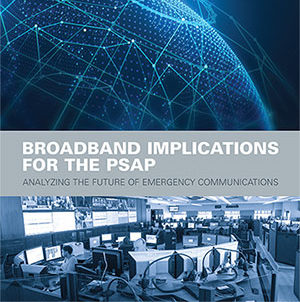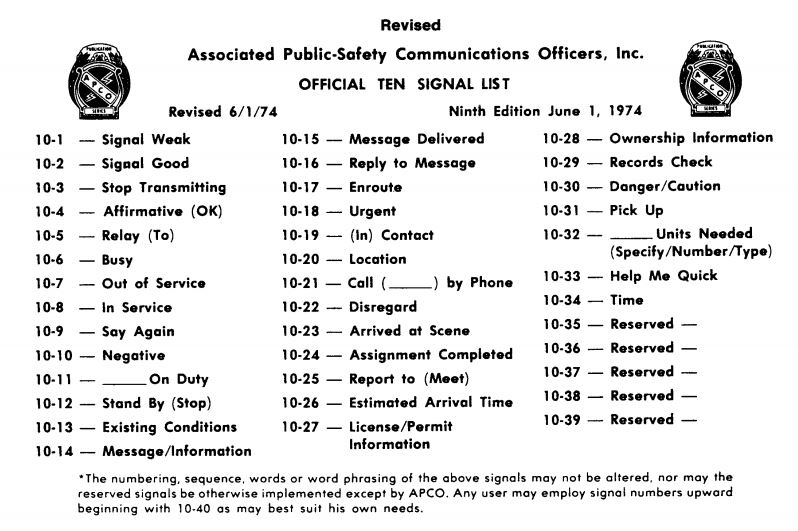APCO’s Project Series
APCO International serves public safety communications through a series of projects aimed at solving the unique problems telecommunications professionals encounter.
In response to technological advances and procedural changes, APCO establishes projects to identify the wants and needs of members. Working with other organizations as appropriate, APCO uses these projects to develop industry protocols and standards. One of the earliest Projects was the establishment of the familiar “10 Codes” in 1937.

A standardized set of signals, or 10 Codes, were included in APCO Project 2 (1967) and revised in APCO Project 14 (1974).
1960s
Project 1 (1966): Film – The Little We Have
APCO’s first numbered project was the production and distribution of a color film titled “The Little We Have.” The film was distributed to individual chapters to spread the word that public safety frequencies for land mobile radio use were severely limited. The intent was to pressure the FCC to address frequency reallocation as a solution to the frequency shortage problem that resulted from the rapid growth of mobile communications.
Project 2 (1967): Public Safety Standard Operating Procedure Manual
In 1966, APCO received a grant for the research and development of a public safety communications standard operating procedure manual. The manual addressed radio, teletypewriter and radiotelegraph use, and was the first attempt to standardize two-way radio use. More than 23,000 copies were sold by April 1971, and it was was translated into French, Spanish and Japanese.
Following the manual’s distribution, a debate arose about putting civilian operators – particularly females – in communications centers. Agencies wanted to free their (male) sworn officers from comm center operations and put them back in the field. The use of standardized procedures meant it was no longer necessary to have a sworn officer at every position in the comm center and led eventually to the creation of today’s public safety telecommunicator position.
1970s
Project 3 (1970): Chicago Public Safety Spectrum Requirements Study
APCO’s Project 3 studied police communications in the metropolitan Chicago area. The aim was to develop and implement a communications plan for more effective law enforcement in the area. Like many metropolitan areas, it had a severe shortage of frequencies available for public safety use. Law enforcement agencies were unable to provide for their radio basic needs, much less use the newest equipment and communications techniques. This shortage created a danger to the officers in the field and to the citizens of those areas. Project 3 addressed the problem as stemming from the FCC’s inability to foresee and reorganize the spectrum to accommodate the rapid growth of land mobile radio services.
Project 4 (1973): National 10 Signal Study Cards (1st Review)
In keeping with the trend toward standardization, APCO developed “Ten Signal Cards.” Agencies were quick to adopt the “ten signals” for official use. Although the actual codes had evolved over time, this project was the first attempt to address the need for standards in radio language, a basic tenet of interoperability.
Project 5 (1971): Public Safety Standard Frequency Coordination Manual
Under Project 5, APCO developed and published a public safety frequency coordination manual. The goal was to to strengthen and accelerate the entire coordination process, assisting agencies in locating and securing frequencies for land mobile radio use
Project 6 (1971): Experimental Conference Video Taping
The CCTV filming of the 1970 Clearwater Conference was designed to show members how a national conference operates and the issues being discussed by public safety communications leaders. It was also meant to familiarize the membership with its leaders and see them in action. While APCO hoped to increase participation by lending the film to the chapters, no chapters or members requested the film in the six months following publication.
Project 7 (1977): LIFELINE: A/V Dispatcher Training Course
Project 8 (1971): Conference Rules Manual and Chapter Secretaries Manual
Project 9 (1974): Introduction to the Theory of Waiting Times for Public Safety
Project 10 (1978): AN: The APCO Story
Project 11 (1975): AN: Communication Leadership Skills
To meet the demand for basic radio operator and dispatcher training, APCO developed a course based on the Public Safety Standard Operating Procedures Manual. The course used audio-visual aids and simulators to supplement standard training tools. The course was designed as basic training for all those involved in all aspects of public safety. It included sections for the supervisory and non-supervisory level, and for large and small departments.
Project 12 (1973): Municipal Spectrum Requirements
Project 13 (1974): Comm Review and Assessments in State SPAs
Project 13 provided a resource to help members make more effective applications for Law Enforcement Assistance Administration (LEAA) grants. After surveying agencies that had recently received LEAA funding, APCO created a checklist to ensure their plans reflected real requirements, were technically feasible, had been properly coordinated and had the vital elements to guarantee success.
Project 14 (1973): Study of Aural Brevity Codes
Through surveys, the committee determined the benefits of aural brevity codes, such as 10-4. These included improved accuracy within and between systems, reduced response times, enhanced system discipline, increased privacy, more efficient use of training time and the applicability to system keyboard indexing. They found that the numeric-only format was most suitable and suggested the already popular “10” as a prefix.
The result was the publication of a revised “Ten-Signal” code. The committed recommended it be adopted as a national standard, to maximize interdepartmental cooperation and to minimize training concerns. They also endorsed the international phonetic alphabet as the standard for the public service community.
Project 15 (1973): IACP Survey of Public Safety Communications
Project 16 (1977-1985): Application of the 900 MHz Band to Law Enforcement Communications
The opening of the 900 MHz band by the FCC offered the public safety community the chance to develop communications systems with significantly enhanced capabilities. Project 16 addressed specific characteristics and functional capabilities of those systems.
The goal was to create a system concept that would satisfy the minimum needs of all potential users and permit more complex requirements by other users or in the future. Project 16 addressed channel access times, automated priority recognition, data systems interface, individuality of system users, command and control flexibility, system growth capability, frequency use and reliability. The final document described a multi-channel mobile communications system that uses digital addressing techniques and frequency switching systems.
- The Application of the 900 MHz Band to Law Enforcement Communications
- 900 MHz Trunked Communications System Functional Requirements Development
- The Operational Impact of 900 MHz Radio Systems on Law Enforcement Communications
Project 17 (1978): Law Enforcement Communications Problems and Recommended Solutions – A Technical Assistance Program (1978)
Under Project 17, APCO formed the Technical Advisory Program (TAP). APCO members skilled in communications management, planning, programming and funding assisted other agencies. The goal was to provide a source of solutions to common problems that occur in communications centers. The most common problems occurred in the areas of system design, spectrum management and dispatcher training.
The committee found that inefficiency was often caused by a lack of familiarity with communications concepts by senior policy-making personnel, who may have had little or no background in communications before assuming responsibility for a comm center. The committee recommended that all middle and senior management complete training on the basic concepts of communications systems organization, management and regulatory control.
1980s
Project 18 (1982): Analysis: Management of Emergency Channel 155.475 MHz (1982)
Project 19 (1982): Operation SECURE: To Establish a Nationwide Civil Disaster Radio Response Program in the 2-10 GHz Bands
Project 20 (1982): Development of PSAP Guidelines
Project 21 (1984): Frequency Coordination Data Base and Operations
Project 22 (1985): Public Safety Telecommunicator Training Courses
Project 23 (1987): Report on Public Safety Systems Interoperability
Project 24 (1985): Public Safety Technician Testing & Certification Program
Project 25 (1989): Technical Standards for Digital Communication Systems for Public Safety Applications
As a joint effort of APCO and the National Association of State Telecommunications Directors, Project 25 was created to develop standards for digital telecommunications technology. It included efforts to determine consensus standards embracing interoperability, spectrum efficiency and cost economies.
More than 30 standards were set with six basic interfaces, including common air interfaces (CAI), data interfaces, intersystem interfaces, network and network management interfaces, public-switched telephone network interfaces and host data interfaces. The CAI in particular impacts interoperability by addressing channel bandwidth, bit rate and access, as well as modulation methods.
Project 25 continues to impact the design and development of new equipment in the telecommunications industry. Learn more
Project 26 (1989): Metropolitan Area Spectrum Acquisition
APCO established Project 26 with public safety organizations in the tri-state region of New York City, New Jersey and Connecticut. The goal was to obtain radio spectrum relief in urban areas that were experiencing spectrum shortfall. If successful, the agencies would use a television channe to aid in expanding and reorganizing radio systems, thereby eliminating overcrowding. In 1992, APCO submitted an application for waiver to the FCC on behalf of the New York City agencies and metropolitan area jurisdictions. The effort to alleviate overcrowded radio channels in metropolitan areas in the United States was successful.
Project 27 (1989): Publication Services – How to Write an SOP Manual; The Primer of P/S Telecommunications System
1990s
Project 28 (1990): Defense of 2 GHz State and Local Microwave Systems
When the FCC considered reallocating radio frequency bands currently occupied by public safety organizations to new PCS and mobile satellite services, APCO determined the reallocation of public safety agencies to other frequencies would be too costly and not as safe or effective as the existing frequency being used. In response, APCO and the National Association of State Telecommunications Directors (NASTD) asked city and state officials to petition Congress and the FCC. A year later, the FCC indefinitely grandfathered all current state and local government licensees occupying the 2GHz band.
Project 31 (1990): Communications Act Amendments
Project 30 (1990): APCO Building Fund
Project 31: (1991): Impact of Wireless Communications Systems on Enhanced 9-1-1 Services
With the onslaught of wireless telecommunication, APCO was concerned about present and future PCS transmissions clogging radio airwaves allocated to public safety. APCO was successful in having the FCC add a provision in its Appropriations Authorization bill, which would prevent public safety from being bumped off its microwave spectrum.
Project 32 (1993): Strategic Plan
In order to grow with an ever-changing telecommunications environment, APCO broadened its primary focus on public safety to include providing support to technicians, maintenance personnel, computer support and managers and directors. Officials also called for expansion of APCO’s membership base to include decision-makers, planners and system developers who could make valuable recommendations on technological solutions to their agencies. It was also decided to work closely with related organizations to develop joint standards for the technological changes taking place in the telecommunications field.
Project 33 (1995): National Public Safety Telecommunicator Training Standard
In 1995, many states had not developed any standardized training for their agencies. APCO decided to develop a telecommunications training standard for public safety agencies nationwide (National Public Safety Telecommunications Training Standard). Experts from public safety communications agencies throughout the nation collaborated with the National Emergency Number Association (NENA) to evaluate what type of standardized training programs (if any) each state had. This information helped APCO build the foundation for APCO ANS 3.103.2: Minimum Training Standards for Public Safety Telecommunicators, which is the minimum standard used today. APCO’s Agency Training Program Accreditation, a formal mechanism for public safety agencies to certify their training programs as meeting APCO American National Standards (ANS), is an initiative of Project 33.
Project 34 (1993): Phase Two of Project 25
An offshoot of Project 25, this project addressed wideband aeronautical and terrestrial mobile digital radio technology standards for the wireless transport of rate-intensive information. The project committee discovered four generally universal limitations restricting the use of commercial services for mission-critical public safety wireless applications: priority access and system restoration, reliability, ubiquitous coverage and security. Project 25/34 describes a platform that can be installed as a government/ commercial partnership that overcomes these limitations and provides universal access to all subscribers within a carefully controlled and managed network. It establishes standards for the transmission and reception of voice, video and high-speed data in a wide-area, multiple-agency network.
Project 35 (1996): Review on Creation of a Nationwide Public Safety Non-emergency Alternative to 9-1-1
In September 1996, President Clinton and the U.S. Department of Justice proposed a nationwide non-emergency number should be available for citizens. This proposed number (3-1-1) would be an easy-to-remember number and would alleviate some of the crowding on 9-1-1 emergency circuits. APCO concluded a non-emergency access number was essential for all public safety agencies, and 3-1-1 was one way to accomplish this objective. While APCO stressed the importance of having a non-emergency number, it also pointed out public education was more important than the selection of a method by which a call would arrive. APCO also said a functional 9-1-1 system should be in place before a 3-1-1 system is implemented. Many cities did not even have access to 9-1-1 systems at the time of this project. APCO concluded a federal mandate to guide 3-1-1 implementation should not exist, but that individual municipalities and members of local government should make the decision.
Project 36 (1998): Establish Standards for CAD Interoperability
This project was developed to research and develop universal standards for computer-aided dispatch (CAD) and CAD-to-CAD exchanges. The goal was to develop effective processes for the exchange of data between third-party call centers such as alarm companies and PSAPs.
Project 37 (1998): Establish Professional Certification Designation for Public Safety Communications Professionals
The main goal of this project was to provide public safety communications personnel with high-quality certification programs. To help understand what would make the program the best it could be, project developers devised a survey for agencies to complete. The Project 37 Committee compiled the results, researched the information, and gathered related certification program standards and structures for review. The goal of the project was to define and create a set of high-quality, highly visible and valuable standards for certification for public safety communications personnel.
Project 38 (1999): Project LOCATE: Promote Widespread Capability of Receiving ANI/ALI From Wireless Telephones
The purpose of Project LOCATE (Locate Our Citizens At Times of Emergency) was to help PSAPs ready themselves to receive wireless E9-1-1 technology so they may identify the exact location of emergency calls made from wireless phones (in accordance with FCC docket 94-102 Phase II). The committee worked with PSAPs, carriers, local and state governments as well as the FCC in achieving this goal. Project 38 LOCATE was created to find ways to hasten the deployment of wireless 9-1-1 Phase II. From the beginning, public safety recognized the challenges presented by wireless E9-1-1 calls to PSAPs. Many APCO members took the time to submit comments to the FCC regarding “Wireless E911 Location Accuracy Requirements” (PS Docket No. 07-114), Non-service Initialized Handsets (PC Docket No. 08-51), and other specific issues regarding wireless 9-1-1 standards and requirements. APCO officers and members continue working together to strive for better wireless accuracy.
2000 Forward
Project 39 (2001): 800 MHz Interference Issues
This project dealing with safety 800 MHz interference was established to provide multiple, reality based, and where possible, tested short-term (less than 12 months), mid-term (less than 24 months), and long-term solutions for 800 MHz interference issues involving wireless/cellular providers and public safety that can be applied to eliminate life-safety communications interference within the United States.
Project 40 (2001): RETAINS
This project was formed to address the staffing crisis throughout our nation’s communications centers. A task force found that personnel recruitment and retention are key to the staffing of our nation’s 9-1-1/public safety communications centers. They developed a best practices document that provided jurisdictions and agencies guidance and assistance in resolving the crisis in recruitment and retention of 9-1-1/ECC personnel. APCO has conducted three surveys (2005, 2009, 2017) with the resulting reports used to update the RETAINS 3.0 Toolkit.
Project 41 (2006): VoIP and Emerging Technology Location Delivery Challenges
Project 42 (2009): Common Operational Picture
The goal of Project 42 was to identify those areas where standards are needed to achieve system interoperability and create a common operating picture at all levels, horizontal and vertical.
 Project 43 (2016): Broadband Implications for the PSAP
Project 43 (2016): Broadband Implications for the PSAP
Implementation of a new nationwide, interoperable public safety broadband network led by the First Responder Network Authority (FirstNet) place broadband communications into the hands of first responders. Next Generation 9-1-1 technology will enable PSAPs to use broadband data in ways that will transform how the public reaches 9-1-1 and how telecommunicators communicate with first responders. Other IP-based technologies, including those supported through smartphones, tablets, and mobile apps, are widely prevalent throughout the general public and are capable of sending an array of information to the PSAP. As a result, PSAPs of the future will be the nerve center, managing data-rich communications via broadband technology with 9-1-1 callers and first responders.
APCO’s Project 43: Report Broadband Implications for the PSAP, will help telecommunicators, public safety answering points (PSAPs), 9-1-1 authorities, emergency operations centers, and others in the public safety community to embrace existing and prepare for evolving broadband communications technologies that will impact PSAP operations and support emergency responders.

